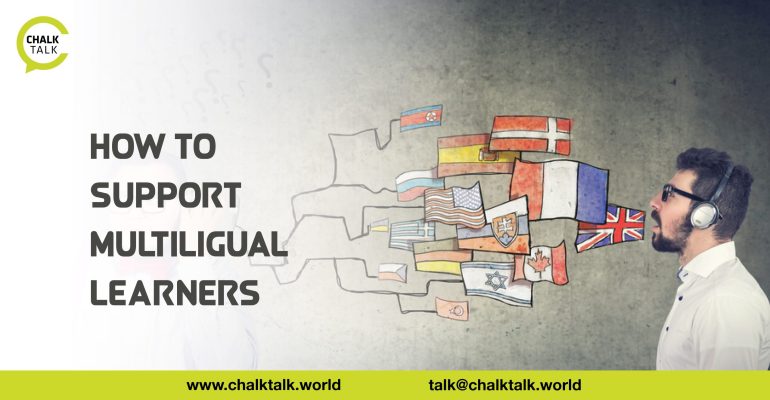How to Support Multilingual Learners: Strategies for Success
July 17, 2023 2023-07-17 8:42How to Support Multilingual Learners: Strategies for Success

How to Support Multilingual Learners: Strategies for Success
In today’s diverse and interconnected world, classrooms are filled with students from various cultural and linguistic backgrounds. These multilingual learners bring a rich tapestry of languages and experiences but face unique challenges in acquiring a new language while mastering academic content. As educators, it is crucial to provide adequate support and create an inclusive learning environment where multilingual learners can thrive. This blog will explore practical strategies and approaches to empower and support multilingual learners on their educational journey.
Understanding Multilingual Learners
Multilingual learners, often called individuals acquiring English as an additional language (ELLs), are students acquiring proficiency in a new language, typically English, while simultaneously developing their academic skills. It is essential to recognize that being multilingual is an asset and that these students bring a wealth of cultural knowledge and linguistic resources to the classroom. However, they may face various challenges, such as language barriers, cultural adjustment, and navigating the complexities of a new educational system.
Creating a Supportive Classroom Environment
To effectively support multilingual learners, creating a welcoming classroom environment is crucial. Teachers can establish a sense of belonging by valuing and respecting students’ cultural backgrounds and languages. Encouraging peer collaboration and fostering a supportive classroom community can facilitate language development and build confidence. Additionally, incorporating multicultural literature and resources into the curriculum can help students see themselves represented and engage with content meaningfully.
Differentiated Instruction
One of the critical strategies for supporting multilingual learners is implementing differentiated instruction. Recognizing that students have diverse linguistic backgrounds and proficiency levels, teachers can adapt their teaching approaches to meet individual needs. Adapting teaching approaches may include:
- Providing bilingual resources.
- Using visual aids.
- Incorporating hands-on activities.
- Utilizing technology tools that support language development.
Differentiated instruction allows students to access the content at their own pace, making learning more meaningful and engaging.
Language and Content Integration
Integrating language and content instruction to support multilingual learners effectively is essential. Rather than viewing language acquisition as a separate process, teachers can embed language development within the context of academic content. This approach helps students connect language and subject matter, promoting more profound understanding and language acquisition. Strategies such as vocabulary scaffolding, graphic organizers, and language-rich activities enable students to engage with content while developing their language skills.
Building Language Skills
Explicitly teaching language skills is crucial for multilingual learners, including targeted grammar, vocabulary, reading comprehension, speaking, and writing instruction. Teachers can incorporate explicit language instruction through mini-lessons, interactive activities, and ongoing language support. Providing language models, sentence frames, and opportunities for practice and application can enhance students’ language proficiency and confidence.
Collaborating with Families and Communities
Collaborating with families and communities is an essential aspect of supporting multilingual learners. Engaging families in their children’s education fosters a strong partnership that benefits the student’s language development and academic success. Teachers can communicate with families in their home language, provide resources for language support at home, and involve parents in school activities and decision-making processes. Connecting with community organizations and cultural events can further enrich students’ learning experiences.
Expanding Language Opportunities
In addition to creating a supportive classroom environment and implementing differentiated instruction, it is crucial to provide multilingual learners with diverse opportunities to practice and develop their language skills which can be achieved through authentic and meaningful language experiences. Teachers can encourage students to engage in conversations, debates, presentations, and group projects that promote language use and interaction. Incorporating language-focused activities, such as journaling, storytelling, and role-playing, allows students to express themselves creatively and further develop their language proficiency.
Furthermore, leveraging technology can be a powerful tool to support multilingual learners. Educational apps, online language resources, and interactive digital platforms provide additional opportunities for practice, self-paced learning, and access to authentic language materials. Technology can facilitate language acquisition by offering multimedia resources, interactive language exercises, and instant feedback. Integrating technology into instruction can enhance multilingual learners’ engagement, motivation, and language development.
Emphasizing Cultural Awareness
Promoting cultural awareness and fostering an appreciation for diversity is integral to supporting multilingual learners. It is vital to create opportunities for students to learn about their cultural backgrounds and those of their peers. Celebrating cultural events, sharing traditions, and exploring global perspectives help build empathy, respect, and a sense of belonging within the classroom. Teachers can incorporate multicultural literature, music, art, and history into their lessons to expose students to various cultural experiences, which enhances language learning and promotes cross-cultural understanding and global citizenship.
Conclusion
Supporting multilingual learners is a shared responsibility that requires intentional strategies, cultural sensitivity, and a deep understanding of language acquisition processes. By creating a supportive classroom environment, implementing differentiated instruction, integrating language and content, building language skills, and collaborating with families and communities, educators can empower multilingual learners to thrive academically and socially. Through our collective efforts, we can create inclusive learning spaces where all students, regardless of their language background, can reach their full potential and contribute to a diverse and interconnected world.


